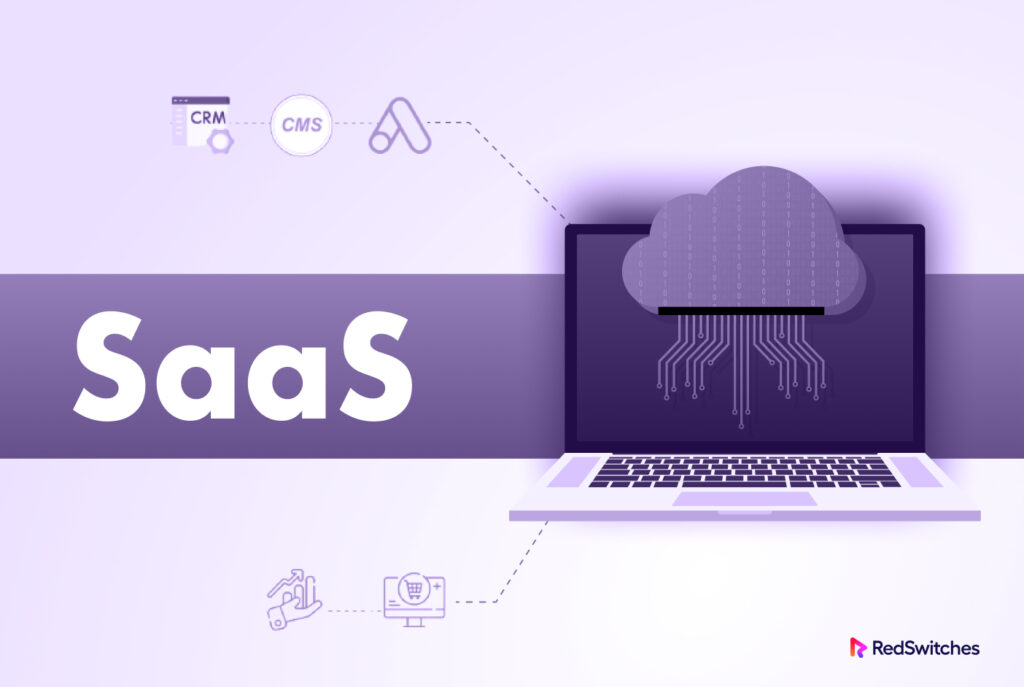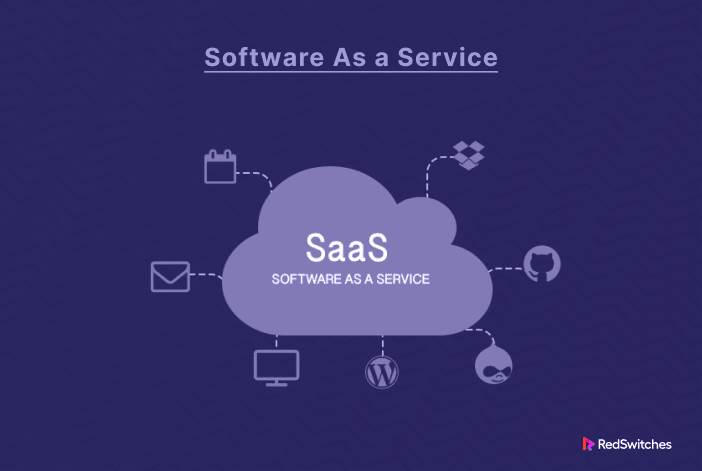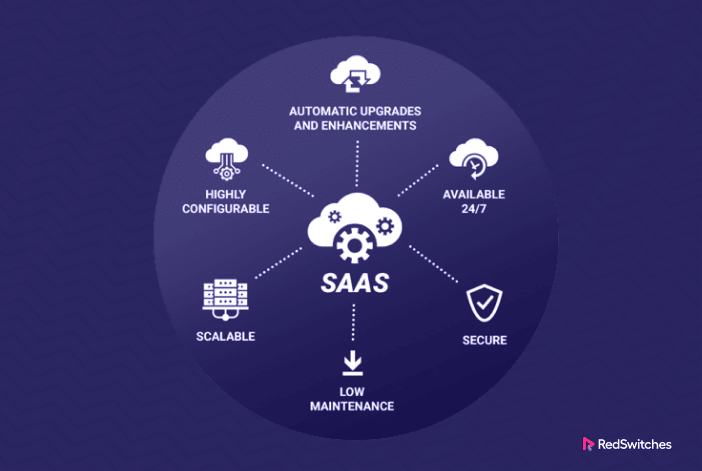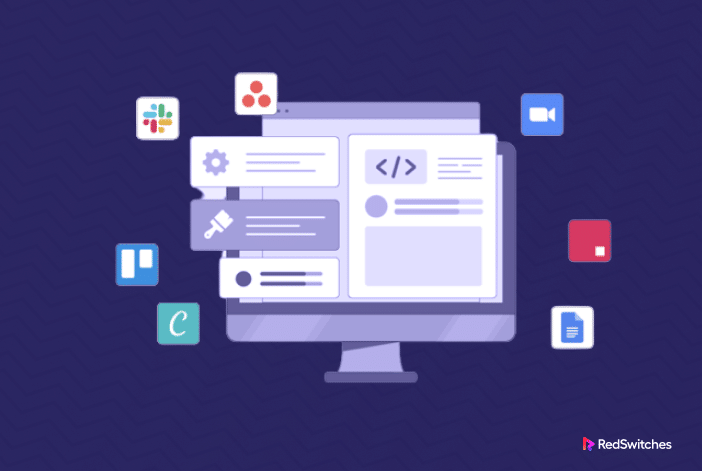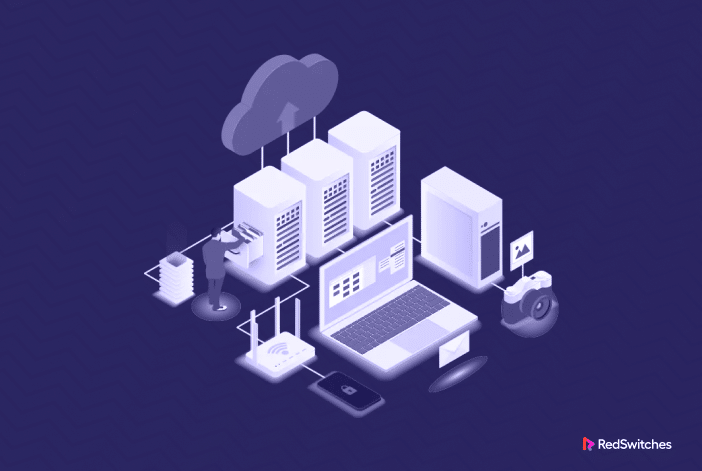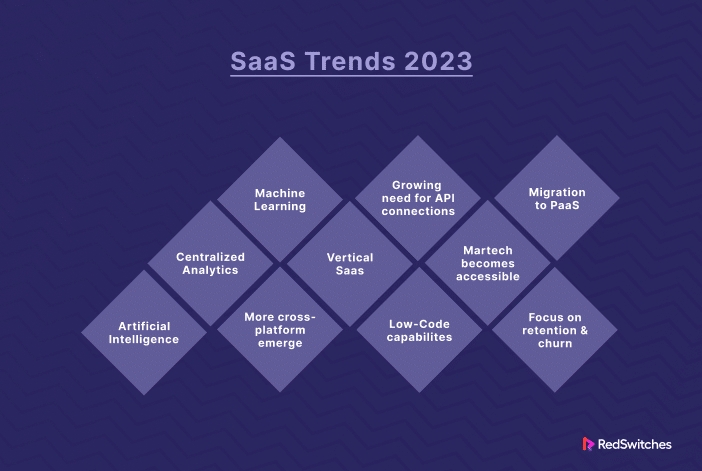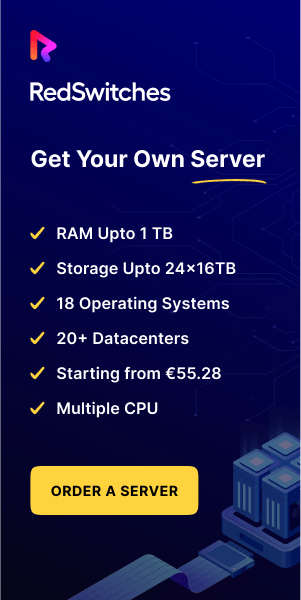Software as a Service, or SaaS, enables users to access and utilize cloud applications online.
SaaS in cloud computing is fast replacing on-premises software because it’s more convenient and can integrate easily into business SOPs and workflows without noticeable disruption.
In addition, SaaS is much less expensive because the end users don’t have to pay for software hosting and maintenance. Instead, they only pay subscription fees (monthly or yearly) to access and use the service.
Popular examples of SaaS applications cover a wide range of use cases, including office productivity tools (Google Workspace, Microsoft 365), customer relationship management (Salesforce), file storage and sharing (Dropbox), project management (Trello), and video conferencing (Zoom).
Since SaaS is a popular way to use software on the Internet, we’ll explore how it works, its benefits, and how it differs from traditional software delivery processes.
Let’s start with some definitions.
Table Of Content
- What Does ‘as a Service’ Mean in Saas in Cloud Computing?
- How Does SaaS Work?
- Characteristics of SaaS Products
- Disadvantages of SaaS
- Bare Metal Servers for SaaS
- Use Cases Of Bare Metal Servers For SaaS
- SaaS vs. Packaged Software
- Future of SaaS
- How Do RedSwitches Help Accelerate Your SaaS Ambitions?
- Conclusion
- FAQs
What Does ‘as a Service’ Mean in Saas in Cloud Computing?
Until just a couple of years ago, software developers used to sell standalone copies of their products to users. New versions and patches had to be manually distributed to the users.
Now, the SaaS model allows them to efficiently manage the distribution and maintenance of software for their customers. The developers handle the product’s frontend and backend data processes and deliver the software as a “service” rather than a standalone product.
As a cloud computing model, SaaS has revolutionized how software is delivered, accessed, and used. It represents a fundamental shift from traditional software distribution methods, where users would purchase and install software on their local computers and company servers.
In the SaaS model, software is hosted and provided over the Internet, accessible through web browsers, and typically offered on a subscription basis.
How Does SaaS Work?
Simply put, instead of installing software on your computer, you access SaaS through a web browser.
SaaS applications are hosted on remote servers by the software vendors, which takes care of maintenance, updates, and security. Users pay a subscription fee to use the software, typically monthly or yearly.
This cloud-based model offers advantages like accessibility from anywhere, smooth scalability, automatic updates, and reduced maintenance overhead. For the users, SaaS is an efficient and cost-effective way to access and use software without worrying about hardware and software compatibility issues.
Plus, users can use the APIs provided by SaaS apps to integrate the functionalities in other custom-built applications. These integration options greatly enhance user loyalty, and software developers can generate significant revenues from deploying SaaS in cloud computing environments.
Characteristics of SaaS Products
SaaS cloud solutions are built for all users, regardless of their knowledge and technical skills. In fact, many developers aim to make their products so easy to use that lay users in the target industry could utilize the functionality to achieve their business objectives with just minutes of training.
A quick look at all popular SaaS products will help you identify some common characteristics that are instrumental in the success of any SaaS product. Cloud-based software services offer the following critical features:
Always Available
As a general rule, a SaaS product is always up and running.
This always-availability results from the underlying service delivery infrastructure that the hosting provider manages. In addition, the developers also keep a close eye on the operations so that they can jump in and fix any issues that might arise and prevent users from using the product.
This high availability is one of the critical benefits of dedicated servers and the cloud computing industry that has contributed to the rise of SaaS in cloud computing as the predominant industry model.
Accessibility
SaaS applications can be accessed from anywhere with an Internet connection, allowing users to use these software tools remotely, fostering collaboration and operational flexibility. Accessibility is a critical benefit of virtualization in cloud computing that ensures developers can use various virtualization technologies to deliver services without interruptions.
Automatic Updates
SaaS providers handle software updates, ensuring users can access the latest features, bug fixes, and security patches without manual local installation.
Scalability
SaaS applications are designed to be scalable, allowing users to easily adjust the number of licenses or resources they need as their requirements change. This scalability makes SaaS suitable for both small businesses and large enterprises.
Subscription Model
Almost all SaaS products operate on a subscription basis, typically with monthly or yearly payment options. This pricing model provides a predictable cost structure and often eliminates the need for large upfront investments in critical software products.
Multi-Tenancy
SaaS applications support multi-tenancy, meaning multiple customers or organizations can use the same software instance. The data and configuration for each user are isolated from the rest of the users and the primary application data.
Data Security
SaaS products generally collect a lot of information as they deliver services to users. While most of the information is not sensitive, users often give out critical information that could explicitly identify them or cause a financial loss in case of misuse.
SaaS products have a multi-layer structure with data security at every layer. Developers further protect user data by integrating authentication protocols and encryption algorithms in their SaaS products. In addition, developers often find ways to avoid collecting sensitive user information to prevent legal problems and comply with user-rights protection regulations.
Integration Support
SaaS applications often offer Application Programming Interfaces(APIs) that developers can use to enable integration with other software systems. This simplifies data exchange that can power diverse workflows.
User Support
SaaS providers typically offer customer support to help users with any issues or questions. In most cases, SaaS products have a comprehensive knowledge base and tutorials that users can refer to resolve queries on their own.
Collaboration Tools
SaaS applications include built-in collaboration features such as document sharing, real-time editing, and communication options to enhance teamwork and help users collaborate on multiple tasks.
Cross-Platform Compatibility
Developers build SaaS applications to be platform-agnostic. This design choice means users can access and use these products on most devices and operating systems. This compatibility promotes accessibility and integration with popular tools.
These features collectively contribute to the popularity of SaaS as a convenient, cost-effective, and flexible way to deliver, access, and use software. Users don’t have to worry about buying the right hardware or installing software on their local machines – a win-win situation for everyone!
Disadvantages of SaaS
Like all external resources, SaaS products can introduce business risk where external vendors maintain SaaS products. In addition, SaaS products can have the following drawbacks:
Dependency on the Internet
SaaS applications require a reliable and fast internet connection. Users may experience disruptions in accessing and using the software if the internet connection is slow or unavailable.
Data Security Concerns
Storing data off-site on cloud platforms can raise security and privacy concerns. Businesses must trust their SaaS providers to implement robust security measures to protect sensitive data.
Limited Customization
Some SaaS applications may have limited customization options. This can be a drawback for businesses with unique or project-specific requirements that the standard SaaS configuration cannot meet.
The Downtime Challenge
SaaS services are hosted on remote servers, and occasional service outages or downtime can disrupt business operations if the developers don’t have redundant service delivery infrastructure. While SaaS hosting providers strive for 100% uptime, occasional issues can occur.
Compliance Requirements
Using SaaS can complicate meeting specific industry or regulatory compliance requirements. In most cases, businesses should understand that SaaS products may store their data in various locations and under different legal jurisdictions. Ensuring compliance with each jurisdiction can be a significant undertaking.
In addition, SaaS solutions tailored for private clouds necessitate vendor-provided configuration and training.
Bare Metal Servers for SaaS
All hosted SaaS products face unpredictability.
The volume of users and requests from individual users fluctuates over time. While developers can predict this workload as data accumulates over months and years, they still need reliable infrastructure for service delivery. Many SaaS products in cloud computing opt for bare metal servers because these hosting solutions offer the best mix of resource availability and flexible allocation.
Bare metal servers offer developers privacy, transparency, and excellent control because of isolated, client-only “computing instances.”
The servers can handle heavy workloads typical of popular SaaS products that deliver services to thousands of users.
We at RedSwitches make it extremely easy to host SaaS apps and make them available to users worldwide, thanks to high-performing bare-metal servers that ensure dedicated resources and scalability without breaking the bank. You can fully customize RedSwitches bare metal servers to host your development stack.
Use Cases Of Bare Metal Servers For SaaS
Compared to other hosting solutions, bare metal servers offer significant speed and performance-focused advantages such as resource availability and customization. SaaS in cloud computing is among the most resource-intensive products because of the large volume of concurrent users and significantly higher computational and processing workloads.
Here are five scenarios where bare metal servers outshine the competition.
Databases
A bare metal server is usually the ideal hosting solution for businesses with large databases and lots of queries. SaaS developers eliminate delays and security risks by hosting these databases on bare metal servers. Thanks to the dedicated resources of these servers, developers can ensure sustained high performance, regardless of the users at the application’s front end. This is particularly valuable for SaaS products with heavy database workloads.
FinTech
The speed, effectiveness, and resources offered by bare metal servers enable FinTech apps to deliver the expected level of functionality to all users. In addition, developers can build and deploy appropriate components that provide the required level of security that Fintech SaaS products need to comply with the data security regulations.
AdTech
The rise in mobile and social media usage has led to a boom in digital advertising. Many AdTech businesses face inefficiency on public cloud platforms despite their heavy reliance on real-time big data analytics for improved targeting and performance. Bare metal servers offer the performance and flexibility AdTech products need to deliver functionality without interruptions.
AdTech businesses can scale up their analytics-intensive workloads and experience consistent performance (at much lower costs) by migrating to RedSwitches’ bare metal servers.
MarTech
MarTech is the umbrella term for SaaS in cloud computing that facilitates marketing campaign development, communication, and optimization.
Planning, deploying, and measuring the impact of marketing campaigns generates a lot of data. Delivering sustained performance and the latest features is critical to the success of MarTech SaaS. Developers must invest in bare metal servers to ensure users can leverage their product’s features to achieve their organization’s growth.
EduTech
The promise of mass customizability in education has been a driving force behind the rise of the EduTech sector. As a result, classrooms are evolving because of the emerging EduTech tools like robots, VR classes, and gamified learning that encourage greater participation and retention.
Hosting IoT-based digital classrooms requires a highly flexible multi-user solution that only bare metal servers can deliver. We recommend our bare metal dedicated infrastructure for hosting EduTech solutions that students can access and use from any location.
Gaming and Streaming Platforms
SaaS platforms that deliver online gaming or media streaming services require the capabilities and the dedicated feature set only bare metal servers can provide. Our bare metal solutions ensure low latency, high-quality streaming, and a seamless user experience for your streaming, gaming, and IPTV operations.
SaaS vs. Packaged Software
Choosing between packaged software and SaaS is an important decision that impacts the sustainability and growth of your business. We recommend you go through the following table and discover how SaaS differs from other packaged software.
| SaaS (Software as a Service) | Packaged Software (On-Premises) | |
| Delivery Model | Cloud-based; accessed via the Internet. | Installed on local servers or individual devices. |
| Deployment | Managed by the cloud service provider. | Installed and managed locally by the user or organization. |
| Accessibility | Accessible from anywhere with an internet connection and web browser. | Typically accessed from on-site devices within a company network. |
| Upfront Costs | Lower upfront costs with subscription pricing. | Higher upfront costs due to software licenses, hardware, and infrastructure. |
| Maintenance | Provider manages updates and maintenance. | Users or IT teams are responsible for updates and maintenance. |
| Scalability | Easily scalable to add or remove users/resources. | Scalability may require additional hardware and IT resources. |
| Customization | Limited customization options in some cases. | Highly customizable to meet specific needs. |
| Data Security | The provider is responsible for data security and compliance. | Users have direct control over data security but must implement it themselves. |
| Downtime | Service may experience occasional downtime. | Downtime is typically within the user’s control and responsibility. |
| Licensing Model | Subscription-based pricing with recurring fees. | Perpetual licenses or one-time purchase fees. |
| Updates | Automatic updates, often with no user intervention. | Manual updates that require user action. |
| Integration | Often includes APIs for integration with other software. | Integration may be complex and require customization. |
| Data Ownership | Ownership may be subject to provider terms and conditions. | Users have full ownership and control over their data. |
| User Support | Typically includes customer support as part of the subscription. | User support may vary and may require additional contracts. |
| Collaboration Tools | Many SaaS applications include built-in collaboration features. | Collaboration features may vary and may require additional software. |
| Cross-Platform Compatibility | Compatible with various devices and operating systems. | Compatibility depends on the software’s specifications and may be limited. |
| Cost Predictability | Offers cost predictability due to subscription pricing. | Costs can vary widely and may include unpredictable maintenance expenses. |
Future of SaaS
The future of SaaS is bright, thanks to the cost and operations-related business benefits of the popular cloud computing delivery model. SaaS products will continue to be in high demand as technology removes market entry barriers and businesses continue to focus on automation and improved user experiences.
It’s projected that by 2025, 85% of all businesses will use cloud-based services for their needs. At the moment, this usage is around 70%. That’s a promising sign for SaaS development and hosting businesses.
More than ever, the business world is rewarding innovation, and businesses that deliver SaaS solutions for specialized business requirements have a huge market waiting for them.
We anticipate SaaS applications becoming more intelligent with AI integration, delivering personalized experiences and predictive capabilities. Similarly, edge computing will enable faster, real-time processing, especially for IoT and AR/VR applications. Vertical-specific SaaS solutions will cater to specialized industries, while hybrid cloud deployments and serverless computing offer greater flexibility and scalability.
How Do RedSwitches Help Accelerate Your SaaS Ambitions?
RedSwitches provides various solutions and features to aid companies in migrating seamlessly to the cloud. RedSwitches is an expert in building and maintaining heavy-compute, high-bandwidth, completely customized bare metal servers for companies launching SaaS applications. These servers are available at unbelievably low costs, with server administration and 24/7 customer support.
RedSwitches can provide speed and connectivity no matter where you do business.
Learn more about Red Switches’ bare-metal server and how they add value to SaaS-based products.
Conclusion
SaaS in cloud computing has revolutionized the way we access and utilize software. Its accessibility, cost-efficiency, and automatic updates have made it a go-to choice for individuals and businesses.
For many businesses, SaaS-based products are essential for maintaining operations and building a fantastic user experience. These products add significant value to all stages of business without requiring huge investments in software development, hosting, and maintenance.
We at RedSwitches provide the best-in-class bare-metal hosting infrastructure for SaaS products so that they can deliver uninterrupted services without worrying about scalability, performance, and security.
We offer the best-dedicated server pricing and deliver instant dedicated servers, usually on the same day the order gets approved. Whether you need a dedicated server, a traffic-friendly 10Gbps dedicated server, or a powerful bare metal server, we are your trusted SaaS hosting partner.
Contact us now to host or migrate your SaaS product on Intel and AMD-powered infrastructure.
FAQs
Q1: What is SaaS in the context of cloud computing?
A1: SaaS (Software as a Service) in cloud computing refers to delivering software applications over the Internet on a subscription basis. Users access these applications through a web browser without installing or maintaining them on their local devices.
Q2: How does SaaS differ from traditional enterprise software?
A2: Traditional enterprise software is typically installed on individual computers or servers, while SaaS is hosted in the cloud and accessed through the internet. SaaS eliminates the need for physical server infrastructure management.
Q3: Can you name some major cloud service providers offering SaaS solutions?
A3: Amazon Web Services (AWS) and Google Cloud are two major cloud service providers offering SaaS solutions, infrastructure, and platform services.
Q4: What is the role of application service providers in SaaS?
A4: Application service providers deliver software applications over the Internet as SaaS. They handle the hosting, maintenance, and updates, allowing users to focus on using the software rather than managing it.
Q5: What are the benefits of using SaaS in cloud computing environments?
A5: Some benefits of using SaaS in cloud environments include cost savings, scalability, automatic updates, accessibility from anywhere with an internet browser, and reduced reliance on physical servers.
Q6: How is cloud infrastructure related to SaaS?
A6: Cloud infrastructure provides the underlying computing resources, such as servers and storage, to host and deliver SaaS applications. SaaS relies on cloud infrastructure to function.
Q7: What is the difference between public cloud and private cloud services in the context of SaaS?
A7: Public cloud services are provided by third-party providers like AWS and Google Cloud and are accessible to the general public. Private cloud services are typically hosted on an organization’s infrastructure and may be limited to specific users or applications.
Q8: How does SaaS ensure cloud security?
A8: SaaS providers are responsible for implementing security measures to protect user data. They often employ encryption, access controls, regular security audits, and other measures to ensure the security of their cloud-based software.
Q9: Can you explain the major cloud service models?
A9: The major cloud service models are Infrastructure as a Service (IaaS), Platform as a Service (PaaS), and Software as a Service (SaaS). SaaS provides fully developed applications, PaaS offers a platform for developers to build and deploy applications, and IaaS provides infrastructure resources like virtual machines and storage.
Q10: How does SaaS benefit businesses in terms of access to software?
A10: SaaS provides businesses with easy access to a wide range of software applications without installation or complex licensing agreements. This simplifies software deployment and management for enterprises.
Q11: Are cloud servers the same as physical servers?
A11: No, cloud servers are virtualized servers hosted in a cloud environment, while physical servers are tangible hardware devices. Cloud servers are more scalable and flexible than physical servers.
Q12: What are cloud application services, and how do they relate to SaaS?
A12: Cloud application services refer to a subset of cloud services that focus on delivering software applications over the Internet. SaaS is a specific category of cloud application services.
Q13: Is SaaS accessible only through a browser?
A13: SaaS applications are primarily accessed through a browser, but some may offer mobile apps or other access methods, depending on the provider.
Q14: Can you recommend some popular SaaS applications used in business?
A14: Some popular SaaS applications for business include Microsoft Office 365, Salesforce, Dropbox, Slack, and Zoom.
